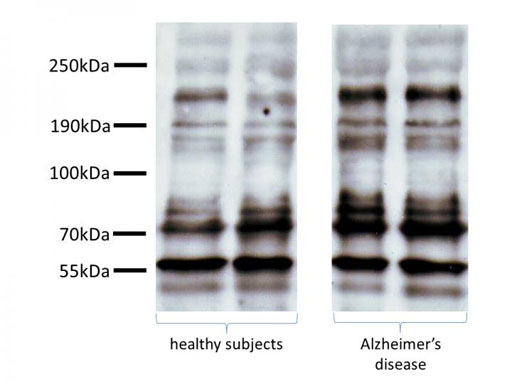Assessment of Tau Protein Status for Early Detection of Alzheimer's Disease
By LabMedica International staff writers
Posted on 03 Jan 2017
The ratio of normal to aggregated tau protein found in blood platelets has been suggested as a biomarker that could be used for the early detection of Alzheimer's disease.Posted on 03 Jan 2017
Investigators at the University of Chile (Santiago, Chile) previously had established the methodology that enables detection of the pathological oligomeric forms of brain tau protein in human blood platelets in patients with Alzheimer's disease (AD) and other neurodegenerative disorders.

Image: High molecular weight tau bands (about 80kDa) can be visualized, with greater immunoreactivity, in patients with AD compared with healthy subjects (Photo courtesy of Dr. Ricardo B. Maccioni, University of Chile).
The current study cited the use of this methodology to determine whether high molecular weight (HMW) or low molecular weight (LMW) tau protein levels, as well as the ratio HMW/LMW, present in platelets correlated with brain magnetic resonance imaging (MRI) structural changes in normal and cognitively impaired subjects. The investigators examined 53 AD patients and 37 cognitively normal subjects recruited from two memory clinics at the University of Chile. Tau levels in platelets were determined by immunoreactivity and corresponding MRI scans were analyzed.
Results published in the December 20, 2016, issue of the Journal of Alzheimer's Disease revealed that the HMW/LMW tau ratio was statistically different between controls and AD patients, and no associations were noted between HMW or LMW tau and MRI structures. The HMW/LMW tau ratio was associated with reduced volume in the left medial and right anterior cingulate gyri, right cerebellum, right thalamus (pulvinar), left frontal cortex, and right parahippocampal region.
The investigators concluded that this exploratory study showed that the HMW/LMW tau ratio was significantly higher in AD patients than control subjects, and that it was associated with the atrophy of specific regions in the brain. Determination of peripheral markers of AD pathology could help in understanding the pathophysiology of neurodegeneration in AD.
Related Links:
University of Chile














